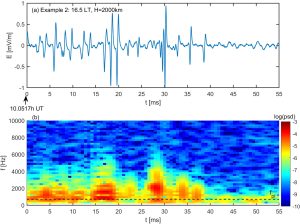〔Visiting Professor Report〕 Professor Amar Kakad, Indian Institute of Geomagnetism, India
Updated: 2023/02/02
Research Activities at RISH on Plasma Waves in Martian Environment
Prof. Amar Kakad (Indian Institute of Geomagnetism, New Panvel, Navi Mumbai, India)
 The purpose of my research at RISH was to understand the plasma waves and associated processes in the Martian plasma environment. Recent studies show that the Martian environment supports full of electromagnetic and electrostatic waves. However, their characteristics and importance in the Martian environment have not been fully evaluated because of the limited spectral domain data from past missions. NASA’s Mars Atmosphere and Volatile EvolutioN (MAVEN) mission, with the capability of high-resolution particle and field measurements, provides a unique opportunity to examine plasma waves in the Martian plasma environment. It is known that the plasma waves play a key role in controlling atmospheric outflow and regulation of particle fluxes in the planetary plasma environment. In this context, examining different plasma waves in the Martian environment is crucial in understanding the loss of the Martian atmosphere.
The purpose of my research at RISH was to understand the plasma waves and associated processes in the Martian plasma environment. Recent studies show that the Martian environment supports full of electromagnetic and electrostatic waves. However, their characteristics and importance in the Martian environment have not been fully evaluated because of the limited spectral domain data from past missions. NASA’s Mars Atmosphere and Volatile EvolutioN (MAVEN) mission, with the capability of high-resolution particle and field measurements, provides a unique opportunity to examine plasma waves in the Martian plasma environment. It is known that the plasma waves play a key role in controlling atmospheric outflow and regulation of particle fluxes in the planetary plasma environment. In this context, examining different plasma waves in the Martian environment is crucial in understanding the loss of the Martian atmosphere.
During the 3-month stay from July to September 2022, I have worked on two topics. The first is to understand the generation mechanism of electrostatic solitary waves that are recently observed in the Martian plasma environment by MAVEN spacecraft. Solitary waves are coherent monopolar, bipolar, and tripolar localized pulses, identified in the high-resolution electric field data with a time duration of a few milliseconds. Such waves and associated processes have never been reported in Martian plasma environments due to a lack of high-resolution electric field measurements. In this context, we attempt to perform the particle-in-cell code (KEMPO) to investigate the evolution of solitary waves and their role in the Martian magnetosheath region.
The second topic is to examine whether the Martian plasma environment supports high-frequency wave fluctuations. These high-frequency fluctuations close to upper hybrid frequency are commonly seen in the Earth’s magnetosphere and they are used to infer the electron density. These fluctuations are believed to be important for the electron diffusion region, which is a core region of magnetic reconnection. Evidence for magnetic reconnection at Martian-induced magnetopause has been reported recently. However, in the case of the Martian magnetosphere, there is no report on the observation of upper-hybrid fluctuations. The MAVEN mission provides an excellent opportunity to investigate the signatures of such fluctuations and associated processes. We identified several such events using MAVEN data. We found that the events seen in the Martian magnetosheath are in many aspects similar to the quasi-electrostatic high-frequency fluctuations detected during quiet times in the Earth’s magnetosphere.
Finally, I would like to extend my sincerest thanks to my host Prof. Yoshiharu Omura for his time, interest, and very warm hospitality during my stay. I hope and expect that our collaboration will continue and expand in the future. I am also thankful to Prof. Yasuke Ebihara and Dr. Yikai Hsieh for the supercomputing system-related discussions. Thanks to Ms. Hiroko Nitto san for helping me in all administration and guest house matters.



